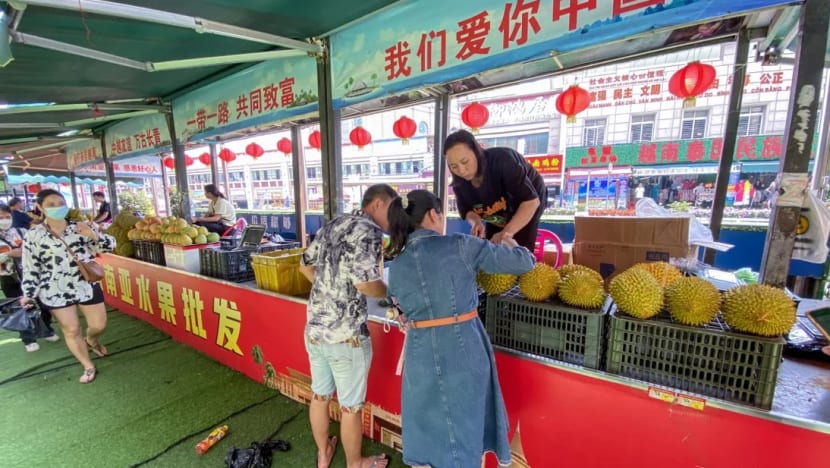China's Vietnamese durian imports seen pushing total demand for fruit to nearly 1 million tonnes a year

Durian is now the most popular imported fruit in China, with billions of US dollars in sales a year. (Photo: Bob Wang)
- Durian has rapidly become the most popular imported fruit in China, and cities bordering Vietnam are stepping up logistics to ensure fresh supplies can reach any Chinese city in 1-3 days
- Thailand has dominated the durian market in China for years, and now other Southeast Asian countries are cashing in
When Beijing opened its doors to fresh durian from Vietnam in September, Bob Wang jumped at the opportunity.
The fruit importer in southern China has since secured deals with Vietnamese durian farms that boast a total plantation area of about 3,000ha, and he is ordering as much as they can provide.
“If things go well, I will import more than 3,000 containers, or 60,000 tonnes, of Vietnamese durian this year to meet the demand of the Chinese market – three times my import from Thailand,” said Wang, the founder of TWT Supply China, which has more than 3,000 self-owned and contracted truckers nationwide.
Durian has quickly become the most popular imported fruit in China. Despite highly restrictive import controls during the pandemic, China imported about four times as much durian in 2022 compared with 2017, bringing the total value to more than US$4 billion.
“Last year, China imported more than 820,000 tonnes of durians. I’m pretty confident that the import total will easily reach or exceed 900,000 tonnes this year,” said Wang, who has been importing durian from Thailand for eight years.
Durian from Thailand has dominated the Chinese market for years, but that dominance is being challenged due to rising inflows from Vietnam and other countries in Southeast Asia, with Malaysia and the Philippines also looking to expand durian imports to China.
“Imports from Thailand are expected to grow steadily this year, while the market share of Vietnamese durians in China will explode as well,” Wang said. In 2022, he said, 780,000 tonnes of China’s durian imports were from Thailand.
One Chinese fruit retailer explained that “Thai durians are expensive, but they’re tastier and plumper, while Vietnamese durians are being quickly welcomed because of their cheaper prices”.
Wang similarly noted that Vietnamese durians are about 15 per cent cheaper than Thai durians.
The growing market potential for durian in China has pushed cities in Guangxi Zhuang autonomous region, which borders Vietnam, to beef up logistics to facilitate imports from its neighbour.
Chongzuo, a border city in Guangxi, is building an advanced logistics centre with cold-chain storage and food-processing facilities to improve the import process, said Liu Yeke, deputy director of the city’s development and reform bureau.
He said the first phase of investment will reach about 1.8 billion yuan (US$254 million) and will be put into use by 2025.
The access enhancements will allow Vietnamese durians to reach all parts of China within one to three days, according to local officials and traders who expect durian consumption to further rise as a result.
Since April, there have been two cross-border freight trains per day transporting Vietnamese fruit through the border town of Pingxiang, which is administered by Chongzuo, according to Huang Wenhan, a cargo supervisor with the Pingxiang branch of China Railway Nanning Bureau Group.
“Most of [the transported fruits] are durian and mangosteen, as they are the most profitable among tropical fruits,” Huang said.
It usually takes just one or two hours to complete the entry formalities and place the fruit on cold-chain trucks that can then reach supermarkets across the country in less than three days, Huang added.
Chen Xiao, director of Dongxing Port Service Centre in Guangxi, also expects to see considerable growth in durian imports from Vietnam this year.
“In the past, our port was mainly engaged in seafood imports, but this year the import of durian is increasing rapidly. Now it is the peak season for Vietnamese durians, and dozens of large trucks full of durian enter Dongxing Port every day,” Chen said.
Dongxing Port is connected with Mong Cai in Vietnam by two bridges that cross the Beilun River, located on the border.
Rog Chau, a Vietnamese man who runs a small fruit farm near Ho Chi Minh City, said Chinese have started to invest in durian farms in his hometown.
“Many fruit farmers in Vietnam are pivoting to plant durian because it is more profitable due to the huge appetite of the Chinese market,” Chau said.
Wang, the fruit importer, also expects the Regional Comprehensive Economic Partnership (RCEP) to facilitate greater durian trade in the future, and deals made through the world’s largest trade pact could also result in more Asean countries such as Indonesia becoming major durian suppliers to China.
This article was first published on SCMP.


















